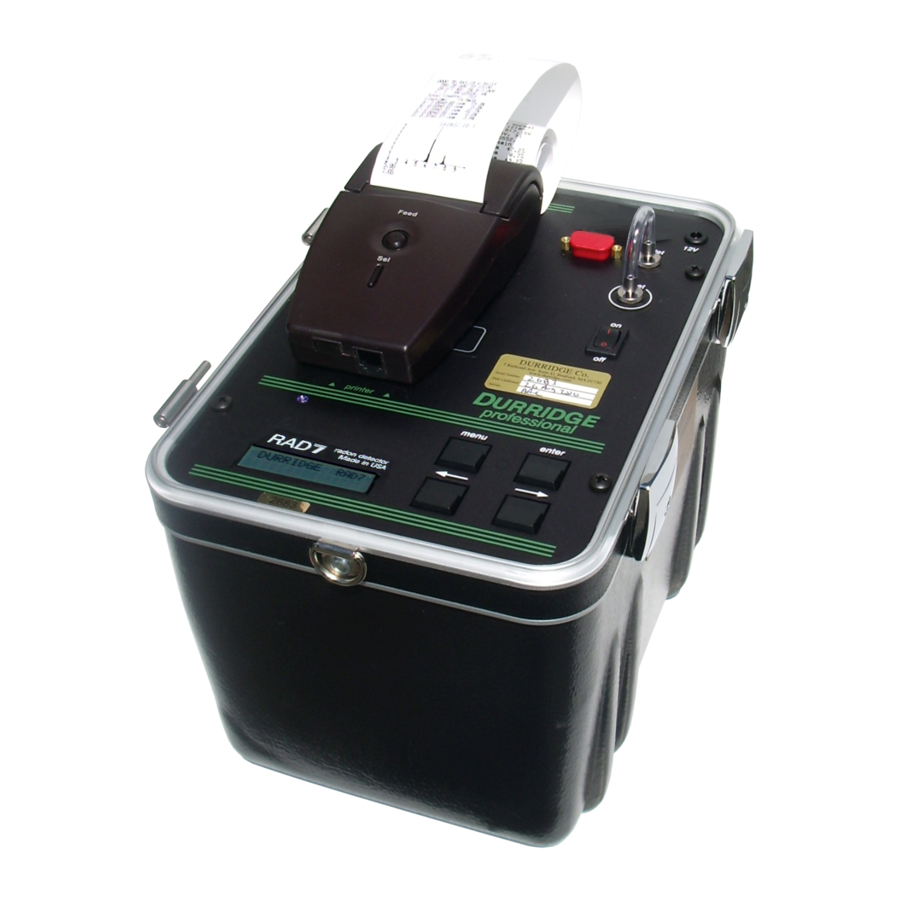DURRIDGE RAD7 Kullanıcı Kılavuzu - Sayfa 8
Güvenlik Sensörleri DURRIDGE RAD7 için çevrimiçi göz atın veya pdf Kullanıcı Kılavuzu indirin. DURRIDGE RAD7 15 sayfaları. Passive, slow response radon in water accessory
Ayrıca DURRIDGE RAD7 için: Bluetooth Bağlantı Kılavuzu (4 sayfalar), Bağlantı Kılavuzu (4 sayfalar), Kullanıcı Kılavuzu (7 sayfalar)

2.2.4 RAD7 Mode
In AUTO (the default) mode, the RAD7 will
automatically switch from SNIFF mode to NORMAL
mode after three hours into the run. This is to take
advantage of the additional counts provided by the
214-polonium decays that will, by then, have
approached equilibrium with the (steady) radon
concentration in the measurement chamber.
For slow, long-term measurements with long cycle
times AUTO mode for the RAD7 is appropriate. The
RAD7's response time will be a couple of hours or so.
2.3 Long Term Measurement
2.3.1 Desiccant
As set up, above, the system will continue making
measurements indefinitely. There are, however,
various resources that are being used up in the
process, and which must be replenished. The most
obvious is the desiccant. A new, or regenerated,
Laboratory Drying Unit will normally last for about
ten days of continuous use in a temperate climate. In
this application, however, it is operating in a closed,
dry air loop where the only moisture entering the
loop comes from tiny leaks of ambient air. Therefore,
each Laboratory Drying Unit can be expected to last
several weeks. When the remaining length of blue
(dry) desiccant is less than one inch, the desiccant
should be replaced. Please see the RAD7 manual on
desiccant regeneration. If the desiccant is not
Section 2
Measurement Procedure
For fastest response, the RAD7 can be forced to stay
Setup, Mode, Sniff [ENTER]
in SNIFF mode (
It will then always count only the 218-Po decays,
giving it a 13-minute 95% response time. However,
the improvement in overall response time is marginal
due to the 2-hour timescale for radon exchange
across the membrane tubing, and this has to be
weighed against the reduction in sensitivity (and
consequent reduction in precision) that comes with
switching from NORMAL to SNIFF mode.
replaced, and the relative humidity in the instrument
rises above about 20%, then the sensitivity drops off
and the reading is lower than the true value.
2.3.2 Memory
The capacity of the internal memory of the RAD7 is
1,000 records or cycles. If each cycle is two hours,
that would be data for 2000 hours, or just over 80
days. Every time the desiccant is changed, therefore,
all the stored data should be downloaded to a PC,
backed up, and erased from the RAD7 memory. It is
also possible to monitor the RAD7's output remotely,
including the relative humidity, which can be used as
an indicator that the desiccant needs to be replaced.
Please see the CAPTURE manual for more
information on remote monitoring.
).
8
